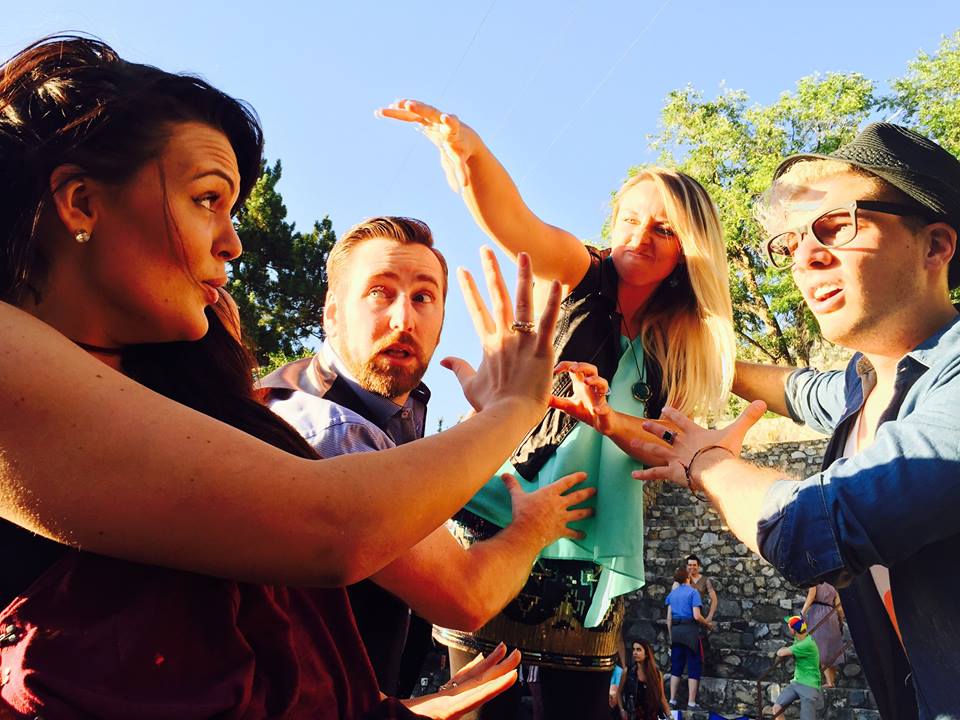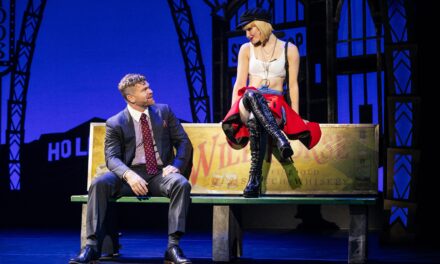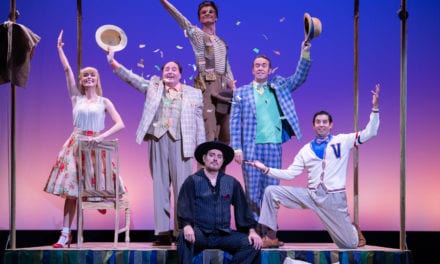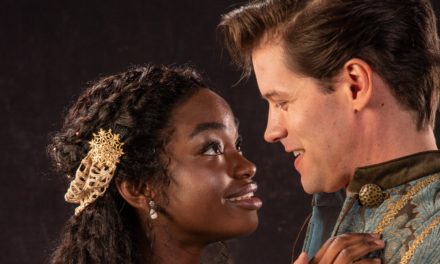PROVO — Shakespeare’s A Midsummer Night’s Dream is known for its carnivalesque elements, illustrated by the blurring of social roles that allows a commoner with a donkey’s head to become the lover of the fairy queen. Renaissance Now Theater and Film’s updated version of the show at the Castle Amphitheater took this aspect of the play to another level when the traditional script of theatergoer and performer was turned upside down by a cell phone ringing — not in the audience, but onstage, in the pocket of the donkey-man himself, Nick Bottom.
Yet, rather than breaking the theatrical spell, the moment contributed to the production’s sense of organic connection to its surroundings that director Kathy Curtiss has cultivated. Between the informal pre-curtain musical warm-up, actors rising out of the audience to join the cast onstage, improvisational asides, and audience participation, a charming, immersive experience takes shape, bolstered by strong central performances and excellent ensemble chemistry to mark a welcome return for the Renaissance Now company to the Castle stage after a five-year hiatus.
A Midsummer Night’s Dream recounts the intermingled misadventures of two pairs of young lovers in the forest, a quarrel between the king and queen of the fairies, Oberon and Titania, the meddling of Oberon’s deputy, Puck, and the shenanigans of a troupe of would-be actors known as the Mechanicals, led by Nick Bottom. Puck provokes shifting affections among the lovers, by way a love potion, and brings about the famous transformation of Bottom’s head into that of an ass, which subsequently draws Titania’s (also bewitched) attention. Bottom and Puck cross the boundaries between the mortal and fairy realms, ultimately tying everyone’s exploits together over the course of a hazy summer’s night.
 Renaissance Now has relocated A Midsummer Night’s Dream, originally set in Athens, to a present-day rock ‘n’ roll festival in New York City’s Central Park—complete with references to the the park’s angel statue, allusions to current events such as the Greek financial crisis, and acknowledgement of some of the characters’ “hipster garments.” As part of Lisa Kuhni’s costume design, the clothes span the spectrum of modern New Yorker garb, including the techie style of the Mechanicals (here styled the “Google Geeks”), with a pop-art Star Trek t-shirt, Google employee ID badges, ubiquitous smartphones, and the occasional tin foil hat.
Renaissance Now has relocated A Midsummer Night’s Dream, originally set in Athens, to a present-day rock ‘n’ roll festival in New York City’s Central Park—complete with references to the the park’s angel statue, allusions to current events such as the Greek financial crisis, and acknowledgement of some of the characters’ “hipster garments.” As part of Lisa Kuhni’s costume design, the clothes span the spectrum of modern New Yorker garb, including the techie style of the Mechanicals (here styled the “Google Geeks”), with a pop-art Star Trek t-shirt, Google employee ID badges, ubiquitous smartphones, and the occasional tin foil hat.
Altering the period and setting of Shakespeare always runs the risk of veering into gimmickry without a clear objective and skilled directorial hand. Fortunately, Curtiss and her team have navigated around this hazard by developing the production concept as a way of turning the idiosyncrasies of the Castle Amphitheatre to the play’s advantage. Specifically, the rock festival conceit shrewdly minimizes the potential distraction of the bass beats wafting up the slope from pool parties at Seven Peaks. Instead, they blend right in alongside the contemporary incidental music and melodies accompanying Shakespeare’s ballads to enhance the bohemian atmosphere.
 Similarly, Ian Biesinger and Aaron Thornton’s understated set—consisting of little more than a few tiered platforms—wisely defers to the pines flanking the stage. Thus, as the evening progresses and the thumping from the party down the hill gives way to the chirping of crickets, nothing impedes the audience’s view of the summer skyscape that is so central to the material. As with the Google Geeks’ play-within-a-play or Bottom’s bridging of the mortal and supernatural spheres, the aggregate effect makes the edges of performance and theatrical space indistinct and permeable.
Similarly, Ian Biesinger and Aaron Thornton’s understated set—consisting of little more than a few tiered platforms—wisely defers to the pines flanking the stage. Thus, as the evening progresses and the thumping from the party down the hill gives way to the chirping of crickets, nothing impedes the audience’s view of the summer skyscape that is so central to the material. As with the Google Geeks’ play-within-a-play or Bottom’s bridging of the mortal and supernatural spheres, the aggregate effect makes the edges of performance and theatrical space indistinct and permeable.
Rick Macy, as Oberon the fairy king, combines excellent diction and an expert naturalness in his line readings with a commanding stage presence that underscores his character’s influence over the meandering plot. He achieves the difficult balance of maintaining an aura of control over the events unfolding before him (often as a background observer) without ever upstaging the rest of the cast. As the disputes among the four lovers reach their boiling point in the third act, Sarah Butler (as Hermia), Dallin Halls (as Lysander), Kat Webb (as Helena), and Patrick Kintz (as Demetrius) all flash intensely as they verbally square off, thrust, and parry under the watch of Oberon’s sovereign eye. At the climactic moment, in another serendipitous blurring of theatrical boundaries, fireworks from the party below punctuated Hermia’s rage at being spurned by Lysander.
Carter Peterson brings a feral mischief to the spirit Puck, with a devilish grin and impish energy that gets away from him at times (to the occasional detriment of his diction). The ebullient Ben Hopkin, as Bottom, and the “Google Geeks” project an endearing, earnest awkwardness that keeps the dramatic momentum high by force of sheer commitment, culminating in a so-bad-it’s-good performance of the play-within-a–play, Pyramus and Thisbe (and a riotous death scene on the part of Bradley MacKay, as Flute).
There is no doubt that the hallucinogenic love potion contributes to the carnivalesque nature of A Midsummer Night’s Dream. Though it would be easy to come up with a twenty-first century version of such a drug (at a rock festival, no less), Renaissance Now’s lively, beguiling production draws in the audience on comic timing and energy alone. At only seven dollars for an adult ticket with other discounts available, this is a spectacular bargain of a play for lovers of Shakespeare, comedy, or late summer evenings.






